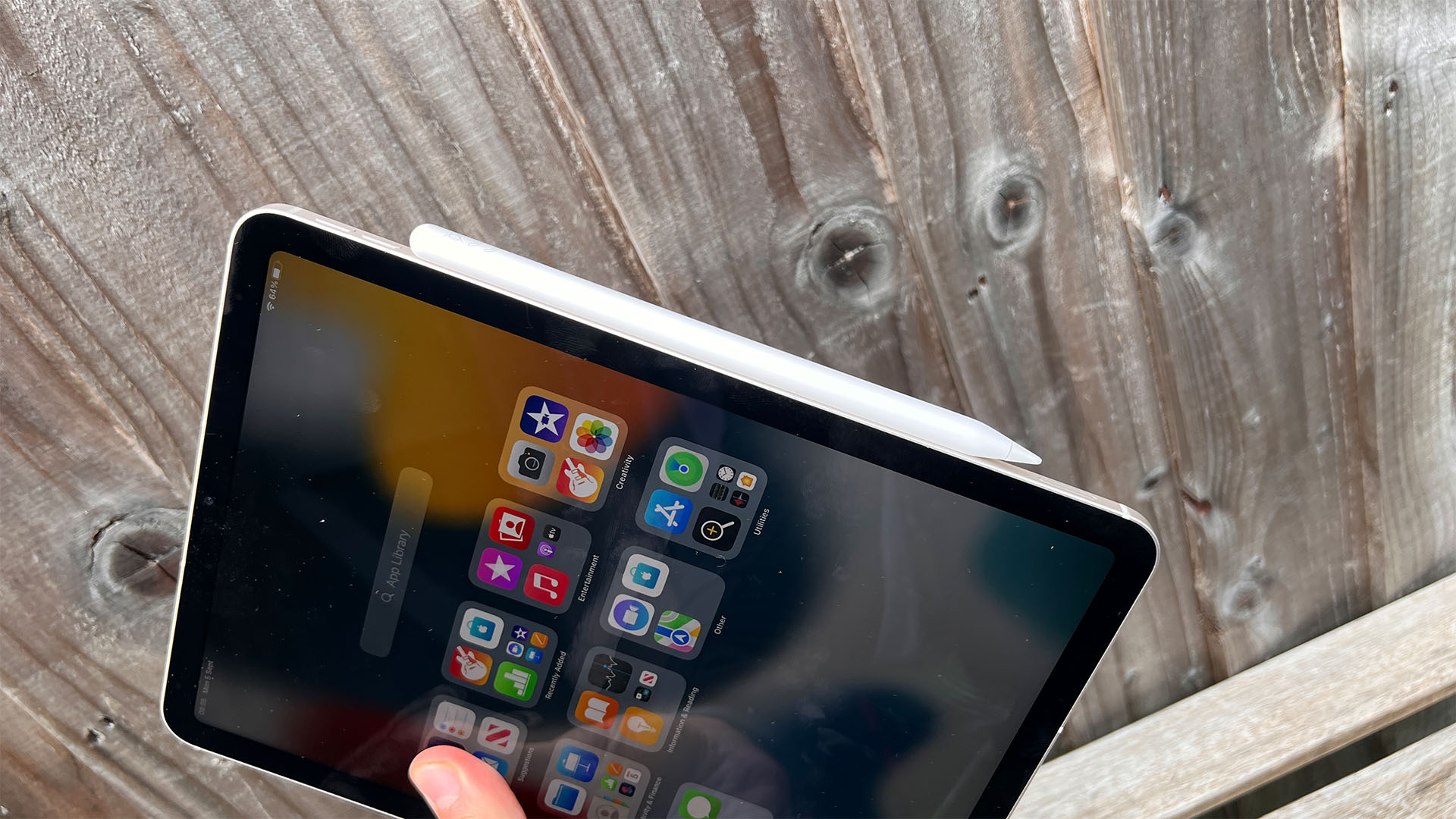Live Science Verdict
The iPad Air M1 feels uniquely placed to be a more accessible tablet than the much more expensive iPad Pro. Its lightweight, looks great, has a stunning display, and offers excellent value for money.
Pros
- +
Good display
- +
M1 chip will support all of iPadOS 16
- +
Priced more reasonably than Pro version
Cons
- -
64GB storage feels too low
- -
Keyboard and Pencil are expensive
Why you can trust Live Science
Price: $599
Screen size: 10.9-inch
Weight: 1.02 pounds (461g)
Memory: 8GB as standard
Battery life: up to 10 hours wireless web browsing
Storage: 64GB and 256GB options.
Warranty: 1 year, extendable with AppleCare.
Operating system: iPadOS 15 (iPadOS 16 compatible)
Display: 10.9-inch Liquid Retina display, 2360x1640 resolution
CPU: Apple M1 chip (8-core CPU, 8-core GPU, 16-core Neural Engine)
Graphics: M1 includes 8-core GPU
Ports: Thunderbolt/USB 4 port
The iPad Air feels like the "Golden Child" of Apple's 2022 tablet lineup by virtue of comparison. The iPad Pro is more expensive, the iPad 2021 is looking dated, and even the excellent iPad Mini won't get every iPadOS 16 feature. It's undoubtedly one of the best tablets for students.
It's competitively priced, too, at $599, although 64GB seems a tad miserly, particularly if the iPad Air is expected to be your main device. Still, it's impressive that it could be your main device — the M1 chip that's packed inside is the same as found on many of Apple's laptops and iMacs, and that means you get great power-per-watt for impressive performance and efficiency.
All of that, packed into a device that weighs 1.02 pounds, means that the only question mark is really what you're likely to want to do with it. Sure, it could replace your laptop, but doing so will cost a lot with additional extras like Apple's Magic Keyboard.
iPad Air M1: Set up and usability
Apple's devices, from iPhones to iPads and Macs, all follow much the same setup template; switch the device on, connect to WiFi, log into your Apple ID, and configure any biometric security.
That's the same on the iPad Air M1, and won't take long — and that includes using the TouchID sensor built into the sleep/wake button.

iPad Air M1: Design and specs
At first glance, it'd be fair to say that the iPad Air looks a lot like the more expensive iPad Pro. Its display is a little smaller, but much of the design language is uniform between the two — there's a volume rocker and a spot for the Apple Pencil to attach and charge on one side, and a wake/sleep button on the top (the iPad Air's version includes a TouchID button, though).
The bezels are similarly thin, with rounded corners on the outer edges and the display itself. There's a 12MP front-facing camera, while the rear camera is a single 12MP snapper.
Get the world’s most fascinating discoveries delivered straight to your inbox.
At the bottom, there's a USB-C port for charging, with the option to connect accessories, too, and a pair of speaker grilles. The iPad Air comes in Space Gray, Starlight (off-white), Pink, Purple, and Blue colorways.

iPad Air M1: Features and Performance
The big addition to the iPad Air this time around is the M1 chip, so it's fair to focus on that here. It's a powerful chip that incorporates a CPU, GPU, and plenty more into the same piece of silicon. That means moving data is faster, but it's also more efficient than spreading it between components.
The result? The iPad Air with M1 still hits that sweet spot of 10 hours of battery life, but it's also got an incredible amount of power under the hood. It can power through your workday, whether you're using Google Docs, a calendar, emails and a task manager, but it also has plenty of power left for gaming at the end of the day. It breezes through games like Genshin Impact and Civilization VI.
It's running iPadOS 15 out of the box, but unlike the cheaper and smaller iPad and iPad Mini respectively, it'll get all of the iPadOS 16 features. That means you can connect it to an external display, enable Stage Manager, and get a more desktop-like experience.
For the full experience, though, you may be tempted to invest in a Magic Keyboard accessory. The keyboard itself is great, but there's an argument that it's overpriced and makes the iPad Air around the same price as a MacBook Air with M1. Apple Pencil (Second Generation) is also supported.
iPad Air M1: Price
At $599, the iPad Air M1 is impressively priced (if still taking on some of the infamous 'Apple Tax' for a premium device). Still, the biggest issue with that price tag is the 64GB storage attached to it — if you're a serious iPad user you may be bumping up against that sooner than you'd like, particularly with larger photo libraries.
Of course, Apple does offer a larger version, but $749 doesn't feel like great value. A cynical customer could argue that's a way to nudge you to the Pro instead, which starts at 128GB for $799 on the 11-inch version, but as we mentioned in that review, that's a very expensive tablet itself.
iPad Air M1 review - User reviews
With 4.8 stars out of 5 average star rating on Amazon, the iPad Air M1 is certainly popular. Many have noted that the Air is impressively fast (including charging it), and that the Apple Pencil is well worth it if your use case requires it.
In fact, as we've alluded to throughout this article, many are wondering if the iPad Pro feels a little superfluous as a result.

Should you buy the iPad Air M1?
Your need for the iPad Air M1 will depend on your need for a tablet. It's as powerful as a laptop, cheaper than Apple's least expensive MacBook, and is a great all-round device for media consumption and work, as well as playing demanding games.
If your day-to-day life is likely to be improved by the $300 Magic Keyboard, though, we'd recommend looking to a MacBook instead.
If this product isn't for you
If money is no object, the iPad Pro 11-inch has a better display, double the storage, and FaceID for unlocking — but that's a significant price jump, particularly if you want to add the Magic Keyboard or Apple Pencil, too.
If you're looking for a more affordable tablet, the 10.2-inch iPad 2021 is a great option. Its design won't turn heads, and it lacks the pizazz of the iPad Air's screen and thin bezels, but it'll still run iPadOS and all of your apps — but won't get all of the iPadOS 16 features coming this year.
Lloyd Coombes freelance tech and fitness writer for Live Science. He's an expert in all things Apple as well as in computer and gaming tech, with previous works published on TechRadar, Tom's Guide, Live Science and more. You'll find him regularly testing the latest MacBook or iPhone, but he spends most of his time writing about video games as Gaming Editor for the Daily Star. He also covers board games and virtual reality, just to round out the nerdy pursuits.



